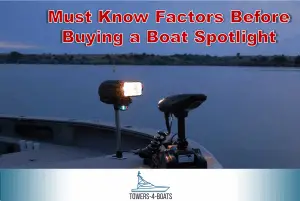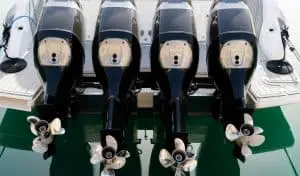Simple Guide to Boating Navigation
To help us locate routes and navigate our way through coastal waterways, ATONs, or Aids to Navigation, are located.
It is important to understand what they mean, as they can alert you of obstructions under the water or be there to lead you back to shore through channels.
You will also discover that there are numerous systems of ATONs based on your location. For example, the United States has a much more complex system and has more navigational buoys and beacons compared to our neighbors to locate and keep track of.
To avoid confusion, there was also a time when the Standardized State Waterway Marking Scheme (USWMS) found between lakes and inland rivers was phased into the United States Aids To Navigation System (USATONS). Between the two networks entering and leaving canals and riverways, boaters will become confused. Today, luckily, the navigation systems in use for boaters are simpler and a lot better.
Is a Buoy Different than a Beacon
For both buoys and beacons, you should be on the lookout. This is the best way to differentiate between the two: A buoy is floating; a beacon is set.
In the sea, buoys float about but are moored to the bottom. There’s a lot to know about these because, for navigation, their form, color and numbering are all important.
The beacons do not float. For starters, lighthouses are beacons. Anything stationary and fixed to the earth may also be beacons. This implies that they may also be poles and structures that could obstruct the water.
Buoys: Shapes and Their Importance
Cans (Cylinders)
You’ll see these are a standard form of a buoy. And they are often a solid color of green. You will find them to have a number often, which is often an odd number.
Nuns
There are regular ones as well, and they are always red. Expect it to have a cone-shaped top (think nun’s cap or a crayon tip) if it’s a floating red buoy. Expect it to have a triangular metal sign if it’s a standing marker.
Buoy Colors and Their Meaning
Green and Red Buoys
Buoys striped with a pattern of red and green suggest a junction. You can either switch to a primary or a secondary channel. If you stay straight ahead, though, you’re going to hit something, like rocks!
To understand which way to go, there’s one more step: pay attention to the color on the top to know which direction is preferred.
White Buoys
Several different information can be provided by white buoys. They’re used occasionally in camping areas where there’s swimming. They indicate a speed limit sometimes.
It is a mooring buoy if you find a white buoy with a blue stripe.
Yellow Buoys
Keep clear! It means caution, just like any sort of yellow street sign. Something like dredge lines or shallow shoals may be concealed under the waterways.
And they may display additional details as a pedestrian crosswalk sign, too. You may sometimes need to refer to your GPS or read a nautical map to know how to proceed or which direction to progress.
Black and Red Buoys
There are black and red buoys signaling the threat. When addressing these, you should use prudence. A chart can also show precisely why it’s risky.
Banded Colors
Red and white vertical-striped buoys show that waters have deep, unhindered channels or, in other words, open, safe boating waters.
However, they do not usually go to the port or starboard and are positioned when you leave a channel and join larger water bodies. To enter protected waters, travel beyond them.
They have letters that sometimes signify something, instead of a number. “For instance: The port and city you’re leaving starts with “M.
Odd and Even Numbering Schemes for Buoy Identification
The red buoys are even-numbered, the green buoys are odd-numbered, as I described above. But what do the odd and even numbers exactly indicate? Ok, they’re giving you a hint of the direction your vessel is going.
First of all, recognize that the number of buoys will increase the closer you get to shore. Of course, this is because you will need more help when you come into channels or harbors. There are fewer buoys as you head out to sea and they’re spaced further apart.
Secondly, with this in mind, the closer you get, the buoy numbers will also come down.
Remember always: Red, Right, Returning. It’s a traditional mnemonic device to alert sailors that you’re returning to land if there’s a red buoy to your right.
So the very first buoys you’ll see when you exit the marina and head farther out into coastal waterways are these:
- A green buoy labeled #1 on your left port side can be labeled
- A red nun buoy marked #2 on your right starboard side
And the more you get into open rivers, the higher they climb.
Flashing Lights
What Does a Blinking Marker Mean
You’ve seen a lot of flashing lights if you’ve ever cruised at night. Most boaters rely on their GPS in a world of technology, believing they will never need to know why or for what reasons they are put there.
But let’s presume it stops working with your GPS. You need to be able to find where you are when this occurs. And charts and the support of these lights that you once took for granted are the old-fashioned way of doing this.
Not every buoy or beacon is going to have a signal. But in darker hours, to tell you what each light you see represents and direct your way back to the marina, you’ll need to have a map that serves as an abbreviated legend.
Although there are several chart abbreviations, you can find the standards below, blinking, occulting, rapid, and mesophase.
The colors of the lights will be labeled with R, G, Y, and W on your map (red, green, yellow, and white). Also worth a note: Assume it’s white if there’s no color specified.
Fixed versus Flashing Lights
- F- Fixed Lights- Without flickering, steady light beacons. You won’t ever see them.
- F1-Flashing- A steady beacon but less than the dark with seconds of flash.
- F1 (2) Group Flickering– Groups of two flashes repeated several times a minute. Group Flashing
- F1 (2+1) – Composite Group Flashing — A group of two flashes followed by a single flash, the entirety repeated several times a minute. Iso Isophase All durations of light and dark are equal.
- Oc-Occulting- A periodic interval beacon. The light flash remains on for longer than the dark.
- (A) – Morse Code Short — A series of flashing lights that represent dots and dashes. Typically flashes for the letter. These are also always white lights.
- ISO-Isophase- This light displays equal flashes and dark times. Advice: “iso” means the same.
- Q-Quick- A is heavy, approximately 60 to 80 times per minute flashing.
Note: It may be evident, but it never links up to a beacon or a buoy. The next lights you’ll see will flash blues if you do, and there’s no map abbreviation for that! It means that law enforcement or the Coast Guard are approaching you.
Solid knowledge of buoys and beacons is not knowing that you can learn quickly. Gain some practice and learn how to use your eyes and your charts before you get into trouble and find yourself in a difficult situation.
Conclusions
Try to direct your ship in the dark once or twice, without GPS! Navigating back to shore. If you lose sight of land with damaged or disabled equipment, you’ll feel much more secure.
Also, make sure you pick up the necessary lighting needed for your vessel before you head out for some night practice. And be sure to pack the right equipment for protection.
Although this post is on safety gear for pontoons, it should give you a general idea of the necessities. In open waters, make sure to keep some important things on board at all times.
All in all, just stay calm and enjoy yourself!



